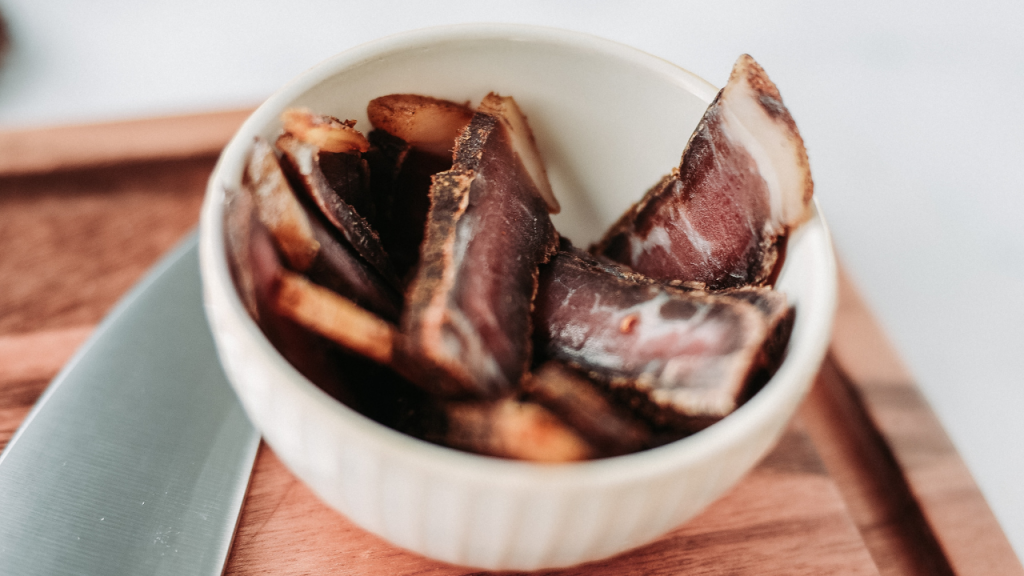Although the process may be tedious, learning how to make biltong is probably the best way to ensure that you always have your favourite snack in your pantry. Making quality biltong requires a little know-how but is still a lot easier than most realise. Here are three basic steps to get you started on learning how to make biltong (the South African way).
1. Meat selection
It is possible to transform a wide variety of meats into biltong (ranging from fish to turkey), but for the uninitiated, beef or game is recommended, as these will suit most tastes. With this, you may select any type of meat of your choice but the standard factors of cut, ageing, and fat content will all affect your biltong in the same way that they do when you’re choosing a meat to cook with. “Venison (silverside) is a popular choice because it is leaner and has higher fat content,” says Michael Makrides, CEO at Biltong Boytjies.
2. Preparation (Cutting, basting & seasoning)
Once you have selected your meat, it’s time to prepare your biltong in the way that you’d like it in terms of size and taste.
Start by removing excess fat, this will assist the drying process and ensure a longer shelf life for the product. Leave some fat for extra flavour, as you like it. If the slices are too thick, they will take too long to dry. A length of about 20cm and a thickness of 1cm is good. Remove any gristle/sinew – such bits become extremely difficult to chew when dry as they are usually tough. Longer strips take up a smaller space for drying and lower the number of drying hooks required.
After cutting your meat into the desired portions, you will need to baste and season your cuts. The easiest way to prepare meat for drying is to baste and season simultaneously. “Worcestershire sauce and brown vinegar are standard basting liquids that have been used to make biltong for many years,” says Makrides. “Vinegar is a great mould inhibitor and helps with the preservation of the meat by killing any mould and bacteria while the Worcestershire sauce adds a deep barbeque flavour to the meat.”
Start by adding a layer of your basting mix and seasoning spices to the bottom of a wide, flat dish or tray. Lay your cuts flat in the dish, then add another equal layer of basting and seasoning on top. Additional spices like paprika, dry chilli flakes and peri peri can be added according to your preference for spicy flavouring. Let the cuts marinade for two to four hours in the fridge before proceeding to the drying phase.
Easy basting and seasoning mix:
For approximately 2kg of meat:
- 250 ml vinegar & Worcestershire sauce – 50/50 – vinegar and Worcestershire sauce mixture – enough to just wet and marinade the meat.
- 1/2 cup ground coriander
- 2 Tbs ground black pepper
- 2 Tbs sea salt
- 2 Tsp paprika
3. Drying
Biltong can be dried in an isolated, dry environment. Most people use a properly constructed chamber (like a biltong maker) that allows one to manage the heat and keep unwelcome visitors like flies at bay. Humidity is the adversary and primary cause of spoiled biltong. Thus, creating the proper drying environment is critical – especially in colder or more humid locations.
“Having a controlled environment during the curing process where you combine airflow, humidity and temperature will give you perfect biltong results all the time,” says Makrides. “When it comes to temperature you want to have it controlled at 25 degrees Celsius at maximum. This will help the meat sweat, lose moisture, and speed up the drying process.”
Makrides warns against adjusting the temperature to a higher degree for the sake of speeding up the drying process. He explains that high temperatures can result in “a funny taste”.
The drying process can take anywhere from 24 hours to 10 days, depending on how much meat you use and how you dry it. Personal taste also comes into play when drying; some people like it moist, while others prefer it rock hard.
ALSO SEE: Try this delicious South African roast potatoes with biltong recipe
Written by Maegan-Leigh Jacobs
Feature Image: Unsplash/Jeff Siepman

